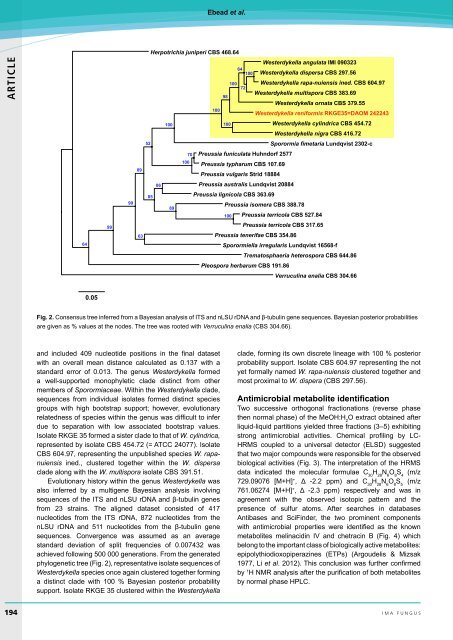Westerdykella reniformis sp. nov., producing the ... - IMA Fungus
Westerdykella reniformis sp. nov., producing the ... - IMA Fungus
Westerdykella reniformis sp. nov., producing the ... - IMA Fungus
Create successful ePaper yourself
Turn your PDF publications into a flip-book with our unique Google optimized e-Paper software.
Ebead et al.<br />
Herpotrichia juniperi CBS 468.64<br />
ARTICLE<br />
<strong>Westerdykella</strong> angulata IMI 090323<br />
64<br />
100 <strong>Westerdykella</strong> di<strong>sp</strong>ersa CBS 297.56<br />
100 <strong>Westerdykella</strong> rapa-nuiensis ined. CBS 604.97<br />
72<br />
<strong>Westerdykella</strong> multi<strong>sp</strong>ora CBS 383.69<br />
98<br />
<strong>Westerdykella</strong> ornata CBS 379.55<br />
100<br />
<strong>Westerdykella</strong> <strong>reniformis</strong> RKGE35=DAOM 242243<br />
100<br />
<strong>Westerdykella</strong> cylindrica CBS 454.72<br />
<strong>Westerdykella</strong> nigra CBS 416.72<br />
Sporormia fimetaria Lundqvist 2302-c<br />
70 Preussia funiculata Huhndorf 2577<br />
100<br />
Preussia typharum CBS 107.69<br />
Preussia vulgaris Strid 18884<br />
Preussia australis Lundqvist 20884<br />
Preussia lignicola CBS 363.69<br />
Preussia isomera CBS 388.78<br />
100 Preussia terricola CBS 527.84<br />
Preussia terricola CBS 317.65<br />
Preussia tenerifae CBS 354.86<br />
Sporormiella irregularis Lundqvist 16568-f<br />
Tremato<strong>sp</strong>haeria hetero<strong>sp</strong>ora CBS 644.86<br />
Pleo<strong>sp</strong>ora herbarum CBS 191.86<br />
Verruculina enalia CBS 304.66<br />
100<br />
52<br />
89<br />
86<br />
99<br />
85<br />
89<br />
99<br />
63<br />
64<br />
0.05<br />
Fig. 2. Consensus tree inferred from a Bayesian analysis of ITS and nLSU rDNA and β-tubulin gene sequences. Bayesian posterior probabilities<br />
are given as % values at <strong>the</strong> nodes. The tree was rooted with Verruculina enalia (CBS 304.66).<br />
and included 409 nucleotide positions in <strong>the</strong> final dataset<br />
with an overall mean distance calculated as 0.137 with a<br />
standard error of 0.013. The genus <strong>Westerdykella</strong> formed<br />
a well-supported monophyletic clade distinct from o<strong>the</strong>r<br />
members of Sporormiaceae. Within <strong>the</strong> <strong>Westerdykella</strong> clade,<br />
sequences from individual isolates formed distinct <strong>sp</strong>ecies<br />
groups with high bootstrap support; however, evolutionary<br />
relatedness of <strong>sp</strong>ecies within <strong>the</strong> genus was difficult to infer<br />
due to separation with low associated bootstrap values.<br />
Isolate RKGE 35 formed a sister clade to that of W. cylindrica,<br />
represented by isolate CBS 454.72 (= ATCC 24077). Isolate<br />
CBS 604.97, representing <strong>the</strong> unpublished <strong>sp</strong>ecies W. rapanuiensis<br />
ined., clustered toge<strong>the</strong>r within <strong>the</strong> W. di<strong>sp</strong>ersa<br />
clade along with <strong>the</strong> W. multi<strong>sp</strong>ora isolate CBS 391.51.<br />
Evolutionary history within <strong>the</strong> genus <strong>Westerdykella</strong> was<br />
also inferred by a multigene Bayesian analysis involving<br />
sequences of <strong>the</strong> ITS and nLSU rDNA and β-tubulin genes<br />
from 23 strains. The aligned dataset consisted of 417<br />
nucleotides from <strong>the</strong> ITS rDNA, 872 nucleotides from <strong>the</strong><br />
nLSU rDNA and 511 nucleotides from <strong>the</strong> β-tubulin gene<br />
sequences. Convergence was assumed as an average<br />
standard deviation of <strong>sp</strong>lit frequencies of 0.007432 was<br />
achieved following 500 000 generations. From <strong>the</strong> generated<br />
phylogenetic tree (Fig. 2), representative isolate sequences of<br />
<strong>Westerdykella</strong> <strong>sp</strong>ecies once again clustered toge<strong>the</strong>r forming<br />
a distinct clade with 100 % Bayesian posterior probability<br />
support. Isolate RKGE 35 clustered within <strong>the</strong> <strong>Westerdykella</strong><br />
clade, forming its own discrete lineage with 100 % posterior<br />
probability support. Isolate CBS 604.97 representing <strong>the</strong> not<br />
yet formally named W. rapa-nuiensis clustered toge<strong>the</strong>r and<br />
most proximal to W. di<strong>sp</strong>era (CBS 297.56).<br />
Antimicrobial metabolite identification<br />
Two successive orthogonal fractionations (reverse phase<br />
<strong>the</strong>n normal phase) of <strong>the</strong> MeOH:H 2<br />
O extract obtained after<br />
liquid-liquid partitions yielded three fractions (3–5) exhibiting<br />
strong antimicrobial activities. Chemical profiling by LC-<br />
HRMS coupled to a universal detector (ELSD) suggested<br />
that two major compounds were re<strong>sp</strong>onsible for <strong>the</strong> observed<br />
biological activities (Fig. 3). The interpretation of <strong>the</strong> HRMS<br />
data indicated <strong>the</strong> molecular formulae C 30<br />
H 28<br />
N 6<br />
O 8<br />
S 4<br />
(m/z<br />
729.09076 [M+H] + , Δ -2.2 ppm) and C 30<br />
H 28<br />
N 6<br />
O 8<br />
S 5<br />
(m/z<br />
761.06274 [M+H] + , Δ -2.3 ppm) re<strong>sp</strong>ectively and was in<br />
agreement with <strong>the</strong> observed isotopic pattern and <strong>the</strong><br />
presence of sulfur atoms. After searches in databases<br />
Antibases and SciFinder, <strong>the</strong> two prominent components<br />
with antimicrobial properties were identified as <strong>the</strong> known<br />
metabolites melinacidin IV and chetracin B (Fig. 4) which<br />
belong to <strong>the</strong> important class of biologically active metabolites:<br />
epipolythiodioxopiperazines (ETPs) (Argoudelis & Mizsak<br />
1977, Li et al. 2012). This conclusion was fur<strong>the</strong>r confirmed<br />
by 1 H NMR analysis after <strong>the</strong> purification of both metabolites<br />
by normal phase HPLC.<br />
194 ima fUNGUS
















